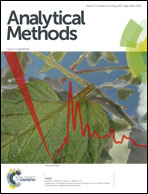Rapid detection of chlorpyriphos residue in rice by surface-enhanced Raman scattering
Abstract
Surface-enhanced Raman scattering (SERS) technology coupled with a quick pre-treatment method is used to detect chlorpyriphos (CP) pesticide residue in rice. 72 rice samples containing CP pesticide residue were prepared for SERS spectra acquirement and GC-MS measurement. The lowest detection concentration of CP pesticide in rice is below 0.506 mg L−1 by SERS technology. Three methods, i.e. Standard Normal Variate (SNV), Multiple Scattering Correction (MSC) and normalization, were used to preprocess the original SERS spectra, and the prediction models of Partial Least Squares (PLS) were established for detecting CP pesticide residue in rice. The PLS model with normalization is optimal, with correlation coefficient (Rp) of 0.9734, root mean square error of prediction (RMSEP) of 1.76 mg L−1 in the prediction, and relative analysis deviation (RPD) of 4.58, which is higher than 3. Six unknown samples were prepared to verify the accuracy of the prediction model. The absolute values of relative deviation were calculated to be between 2.64% and 4.47%, and the predicted recoveries were calculated to be between 96.59% and 104.69%. The value of a T test shows that the prediction model is accurate and reliable. This study demonstrates that the method can achieve a rapid detection of CP pesticide residue in rice.


 Please wait while we load your content...
Please wait while we load your content...